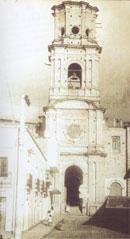Puerto Vallarta in the history
Spanish conquistadors came on March 1525, led by Captain Francisco Cortes de San Buenaventura, a relative of Hernan Cortes. When Spaniards landed here, they found Indians holding banners made of motley feathers. The conquistadors also brought their own banners with the Spanish symbols and the image of Virgin Mary. But the shining armors of Spanish soldiers probably scared natives, who eventually ran away and left their banners behind. From that moment on, the place was called Bahia de Banderas (Bay of Flags).
All through the 16th century, Spanish soldiers kept on coming to its beaches. That was a safe haven for ships sailing back from the Philippines at a time of constant pirate attacks. In the 18th century, people began calling the place Bahia de las Jorobadas (Bay of the Humpbacks) as larger numbers of such whales were being sighted on the premises.
In the 19th century, Puerto Vallarta -as we know it now- was used to load and unload supplies headed for mining companies in Cuale and San Sebastian. At that time in history, the place was known as Las Peñas (The Rocks).
In 1851, Don Guadalupe Sanchez Torres -born in Cihuatlan, Jalisco- started making regular salt deliveries to San Blas to refine the silver extracted from the mines. In the late 1851, Don Guadalupe decided to bring his family to Las Peñas de Santa Maria de Guadalupe. As more families began to settle down, the town started growing little by little and the local economy set sail to lands of prosperity. While some families remained bringing in salt shipments, others took on farming and stockbreeding.
In 1880, Las Peñas had a population of 1,500 inhabitants. In a twenty-year stretch from 1890 to 1910, the city prospered gradually thanks to the combined efforts of the people and to Don Guadalupe's enthusiasm. The discovery of silver deposits in the U.S. made the price of the precious metal crumble down and forced local miners to till the land again.
In 1918, Las Peñas became a municipality and got a new name, Puerto Vallarta, in tribute to Don Ignacio L. Vallarta, the illustrious lawyer who served in office as governor of Jalisco.
By 1930, national and foreign tourists began swarming over Puerto Vallarta. Little by little, the destination became the talk of the town.
In 1954, Mexicana de Aviacion made its first flight from Guadalajara to Puerto Vallarta, thus coming up with a destination that could square off competitively to Acapulco. Among others, Guillermo Wulff came to Puerto Vallarta and the town's second construction phase soon started out. It was Mr. Wulff who introduced domes as architectural elements in several houses and who talked John Houston into shooting a film there in 1963.
Mr. Houston came along with such big-screen stars as Liz Taylor and Richard Burton. The couple bought a house to live their romance there and named it Villa Kimberly, now a museum.
In 1968, Puerto Vallarta won the category of city thanks to the efforts of Francisco Medina Ascencio, governor of Jalisco from 1965 to 1971, who fostered change and development all around. Between 1980 and 1990, the population doubled from 57,000 to 112,000 inhabitants. This leapfrogging pace brought about the building of new hotels and of the Vallarta Marina. However, the year 1993 marked a period of decline for Puerto Vallarta as the inflow of international visitors dwindled sharply. The Joint Tourism Fund was created in 1996 in an effort to boost and promote the destination, both inside and out of the country.
As we speak, Puerto Vallarta is going strong as one of the world's premier travel destinations and that pedestal position is owed to its natural beauties, the incredible amount and variety of activities it has to offer, and to its determination to keep Mexican flavor and culture very much alive.
CHURCH OF OUR LADY OF GUADALUPE
The Church of Our Lady of Guadalupe is one of Puerto Vallarta's landmarks. Its elegant silhouette, crowned by a steeple and angels in the facade, dominates the plaza and the whole town as a token of respect. Many residents make the sign of the cross as they walk past the building.
The very first stone was laid in 1895 when authorities greenlighted the construction of the Church of Las Peñas (former name of Puerto Vallarta). The priest of San Sebastian blessed that first stone.
In 1921, the parish was built and San Jose was anointed as the city's saint patron. As part of an ingrained tradition, the image of Our Lady of Guadalupe was erected on the main altar.
A year to remember was 1942, when Father Rafael Parra Castillo came to the church. This educated and arts-loving man did his best to buttress the worshiping of the Virgin and decorated the temple with genuine works of art.
In 1945, the old brick altar was demolished and replaced by a marble one. The priest asked Mexican painter Ignacio Ramirez to create a new image of the Virgin of Guadalupe for the new altar. The result was simply enthralling. Among other wonders, the path of the cross -cast in plaster and designed by sculptor Jose Esteban Ramirez Guareño- is a standout, as well as the steeple placed atop the dome. The windows and the pineapple-shaped block that supports the cross were designed by Esteban Avalos Haro.
Following many years and countless reforms, the tower was completed in 1965 and legends about the crown began to pop up. The best known of all those stories says that's a replica of the real crown Empress Carlota once wore. The crown was destroyed by an earthquake and eventually replaced by another one made of fiberglass, still standing now on the top of the tower.
This church really has something special. Its open doors lure visitors in to meditate, search their hearts and try to find a few minutes of peace.


































































